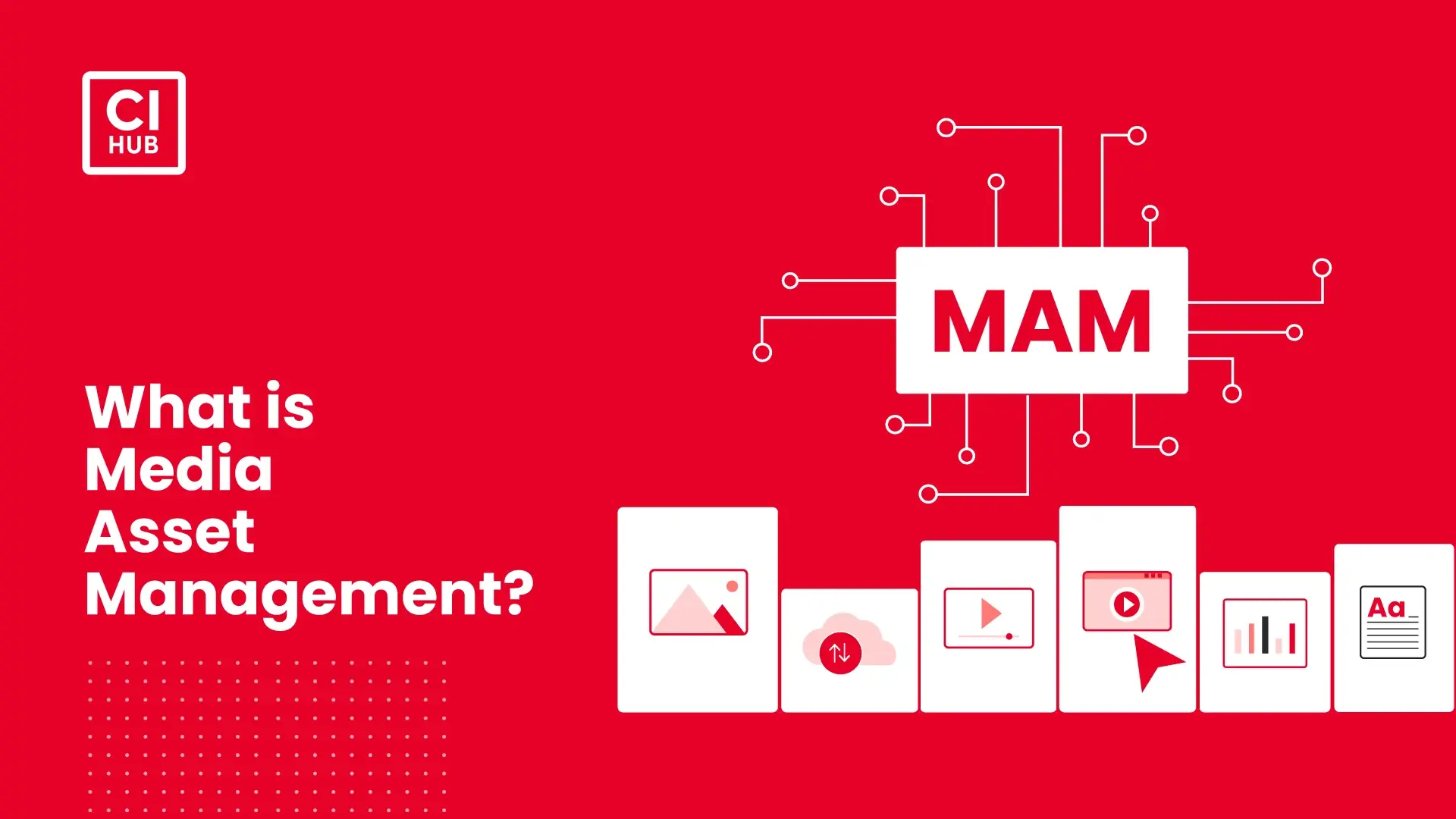Seamless MAM App Integration
Integrate your Media Asset Management system with existing tools to simplify workflows effortlessly.

July 12, 2024
Media Asset Management (MAM) software is a central system for storing, organizing, retrieving, and distributing all types of media assets, including videos, images, audio files, and documents. Designed to streamline creative workflows, MAM provides tagging, categorization, and metadata features so content is easy to find and reuse. While other asset management tools exist, MAM stands out for managing complex media projects and integrating seamlessly with existing applications.
In this guide, we will explain the following:
What does MAM software do?
What Can You Store in A MAM?
Key Benefits of MAM Software for Your Team
How Different Departments Benefit from MAM Software
What Are The Challenges Of Using A MAM?
When should a company invest in the MAM system?
How to Choose the Best MAM Software and Connect It to Your Tools
The Bottom Line
Put simply, MAM software enables companies to store and manage large amounts of media content. It provides a central location for all media files, making them easily accessible to authorized users. MAM software also allows users to add descriptive information (metadata) to your assets, such as tags, keywords, and captions. This can greatly help you find the specific file or document you need, no matter how many you have.
The various features of MAM software include:
If you’re considering a new MAM system, explore our list of providers to find the leading vendors with the latest integrations.
MAM software organizes everything with categories and labels, so finding the specific video, text, or image is easier. It is very helpful for managing and producing content, making it a valuable tool for the marketing department, internal training, and other media-rich company functions. You can use MAM to store, tag, and arrange various media files, for example:
Videos: Videos can be stored in a variety of formats for both regular usage and editing, including MP4, MOV, WMV, AVI, MPEG-2, WEBM, HTML5, and many more.
Image Files: JPG, PNG, GIF, TIFF, and vector files (SVG, EPS, WMF, PDF, AI, or CDR) of product images, experimental shots, and other media assets are examples of these types of files.

Presentations: MAM can easily store PPT, PPTX, and ODP file formats in the system that your team may need, whether for internal crunch calls or general meetings.
Documents: You can also store all types of documents, whether they are in Word format (DOC and DOCX), PDF, HTML files, Spreadsheet files (XLS and XLSX), or TXT.
Audio Files: These are mostly used by the marketing department and are essential for podcasts, social media, and case studies, whether they are MPEG4 audio(M4A), MPEG layer audio 3 (MP3), or Waveform audio files (WAV).
Using MAM software efficiently can benefit every vertical of your organization, from marketing to sales to legal and IT. Here are some of the key benefits of MAM Software.
MAM software organizes your media files in one place, making it easily accessible along with associated data. You can communicate more quickly and access files instantly through one portal.
A significant advantage of MAMs for organizations is the ability to set up different users and groups to protect your IP, ensuring you can share relevant files with relevant people and applications while limiting what shouldn't be shared through privileged permissions
Using a MAM for centralized storage, smart organization, and search tools will save your organization a huge amount of time finding assets. Proxy files can also accelerate workflows by allowing faster uploads and editing. This will reduce storage needs and overall costs.
High video engagement translates to higher ROI, making video creation a must-have for businesses. MAM systems further enhance this by managing video assets, enabling easy social media distribution, and facilitating quick searches with metadata. This allows for content reuse, saving production costs and maximizing the value of your video library.
MAM software can be used to automate tasks, boosting productivity for both individual editors and distributed teams. In particular, approval workflows and intuitive review tools can be set up to ensure brand consistency and make editing processes seamless.
A strong MAM system distributes content at scale across multiple platforms, increasing brand awareness and consistency, which results in increased customer engagement.

The MAM system eliminates the need for sending content back and forth between team members for review. It creates a path for easy project sharing, check-in/check-out, versioning, approval process, and can be accessed from anywhere in real-time.
Video editing bottlenecks vanish with MAM systems. Editors can find archived assets rapidly using contextual search filters and AI-powered metadata. This organized system not only saves time but also unlocks new monetization opportunities for your valuable content library.
MAM eliminates wasted reshoots by making archived assets readily available and reusable. AI and manual tagging streamline discovery with ease, while bulk logging saves editors even more time by applying metadata to entire batches of assets at once.
Big video files overwhelm production and broadcast companies. MAM centralizes assets, streamlines workflows, and automates metadata tagging. This frees creators to produce more high-quality content without getting bogged down in asset management.
Data security is paramount for healthcare and government organizations. MAM offers a secure, internal storage solution for valuable assets, replacing risky practices like cloud storage or external devices. This centralized hub simplifies organization and management, but most importantly, keeps data safe.
MAM provides the insights you need. Analyse editor performance and audience engagement to see what content resonates. Go beyond basic metrics with AI-powered features like logo detection and metadata trends. MAM empowers data-driven decisions for continuous improvement.
MAM software goes beyond just storing your files – and isn’t just useful for marketing and creative processes. It provides a centralized platform for organizing, securing, and collaborating on all your digital assets. Here is how MAM software specifically benefits each department:
Marketing and sales teams can create high-quality content and campaigns with ease using MAM software. Advanced features like automated tagging will eliminate the time-consuming search for assets, while content repurposing tools, social media distribution make it easier to generate and share new content. What’s more, data-driven insights can also help understand what resonates with your audience, leading to more successful campaigns.
MAM empowers creative teams to work faster and smarter. Editors can utilize proxy files for smoother editing, while real-time collaboration features and simplified asset management streamline project workflows.
Additionally, MAM unlocks the value of the content library by facilitating the reuse of archived assets and automating repetitive tasks like tagging, freeing time for creative endeavors.

MAM software strengthens your data security by offering secure internal storage solution for sensitive data, thus minimizing your external storage risks. Centralized access control, audit trails, and streamlined compliance with data privacy regulations strengthen security and free up the IT department to focus on more critical tasks.
MAM empowers data-driven decision-making. Project visibility tools and analytics provide insights into team productivity and content engagement. This allows for informed resource allocation based on editor performance and helps manage content creation costs through the effective reuse of existing assets.
For your company, MAM software opens up a triple benefit. By streamlining workflows and centralizing asset storage, MAM empowers employees to find information faster, collaborate more effectively across departments, and achieve greater productivity.
Switching from a cloud driver to MAM can be beneficial, but it's not always easy to make the switch. Some of the main problems a business can face using the MAM software are discussed below.
It is essential to realize that, unlike general opinion, the MAM tool is for the entire company and is not only meant to support particular databases for marketing and creative teams. MAM's success is based on how well it is accepted by the organization, just like any new technology.
Lack of constant evolution or updating is one of the main problems with newly manufactured technology. To avoid consumers sticking with what they know and refusing to learn something they don't understand, it is crucial to highlight the advantages of the upgraded MAM over the outdated one when it is implemented.
Employees can access the new MAM system with ease! A connector plugin allows them to connect directly through their familiar work apps, granting them access to the assets they need without switching systems.
When your company's video content becomes more specialized, and your DAM system is unable to keep up, you should think about establishing a Media Asset Management (MAM) system. We have listed some important signs telling you it's time for a change.
When rich media files and videos are taking up more space in your media library, you need a system that can handle the needs of processing, storage, and editing.
If your DAM is hindering video production workflow, a MAM system can streamline the processes by offering features like integration with collaborative tools, editing software, and full version control.
When a traditional DAM system struggles with the complexities of metadata, it hinders complex editing, archiving, and categorization.
When you want to deal with highly sensitive data or confidential video content and you require advanced security protocols, access controls, and user permissions to ensure the safety of media assets.
Your company is involved in broadcast media production or live streaming, and the DAM system doesn't provide the functionalities you need, like converting your video into different compatible formats and managing playlists.
Media asset management (MAM) systems are software programs that help organizations store, organize, manage, and distribute digital media files. The following aspects are included in MAM solutions to increase their usefulness and efficiency.
For seamless organization, you can add additional files, documents, and your metadata within MAM Software for better optimization.
MAM software can automatically detect the unlisted data and ingest all files stored with predetermined media formats.
Connecting or integrating the MAM software with popular on-site, cloud storage, and processing services makes it more powerful than a simple media cataloguing solution. To make the files more useful, you can also manipulate the underlying files.
Some solutions in the MAM software offer deeper in-app editing, like a tool for the video production process, but most of the solutions offer viewing and playback for audio, video, and images.
Integrate your Media Asset Management system with existing tools to simplify workflows effortlessly.
Selecting the right MAM system is crucial for efficiency, productivity, and maximizing the value of your media assets. The best MAM solutions simplify media management, streamline creative workflows, and connect seamlessly with the tools your team already uses.
Here’s how to make the most of your MAM system:
Adopting a Media Asset Management (MAM) system equips organizations to handle growing volumes of digital content with greater efficiency and precision. Beyond storage, it streamlines creative workflows, supports collaboration across teams, and ensures assets remain organized and accessible. By integrating with existing tools, a MAM system transforms how content is created, managed, and utilized, helping businesses unlock the full potential of their media libraries while maintaining control, consistency, and scalability across every project.
These days, there are a lot of MAM software companies in the market. See who provides the best integration to ensure your MAM operates smoothly from our suggested list of suppliers.
With CI HUB you can easily connect your MAM system to the apps and tools used by your team. It directly integrates with apps like Adobe Creative Cloud Tools, Google Workspace Apps, Figma, Sketch, Microsoft 365, and many more. WordPress, HubSpot CMS, Joomla, and other Content Management Systems are supported by CI HUB as well.
MAM (Media Asset Management) focuses on storing, organizing, and distributing rich media like video, audio, and images, while DAM (Digital Asset Management) covers a broader range of digital files including documents, graphics, and marketing assets. Simply put, MAM is specialized for media-heavy workflows, whereas DAM manages all digital assets.
MAM systems give distributed teams real-time access to assets, version control, and approval workflows, making it easier to collaborate across locations.

Article by
Michael Wilkinson
Marketing & Communications Consultant of CI HUB